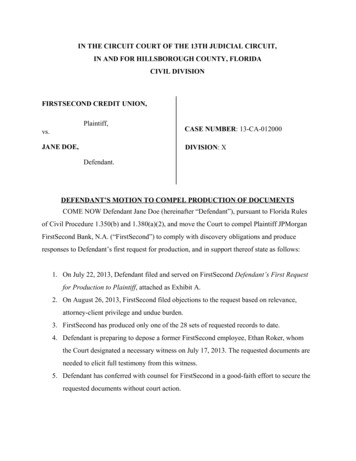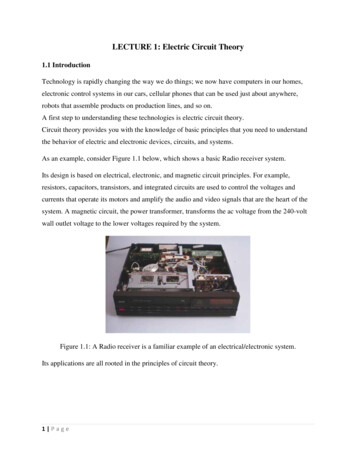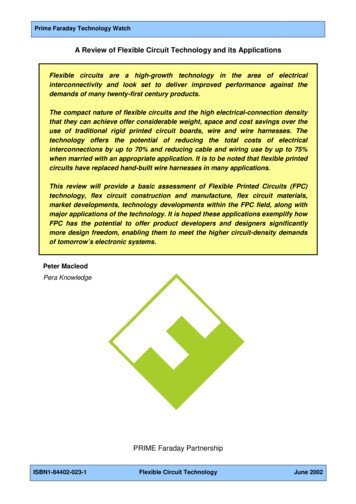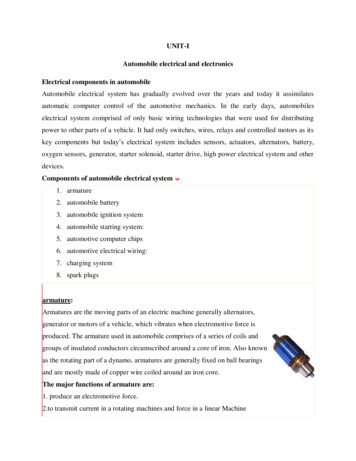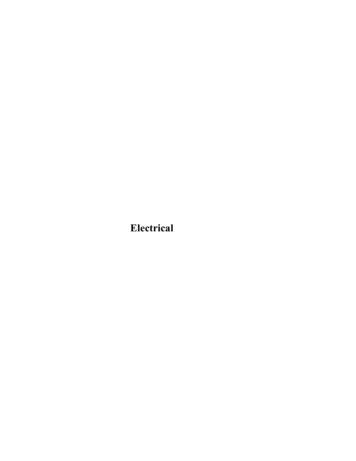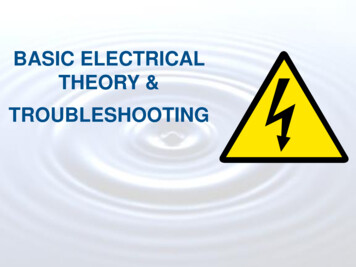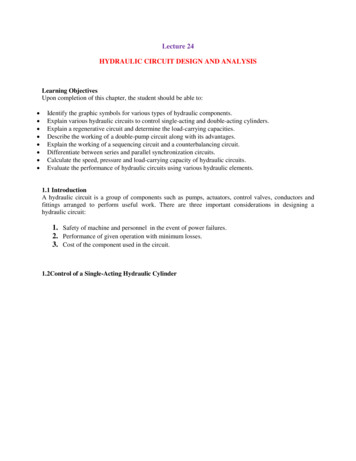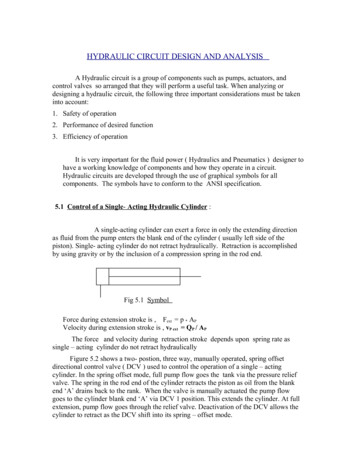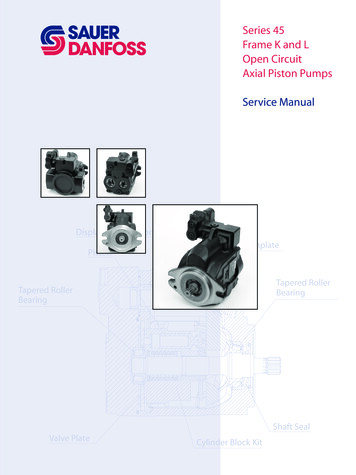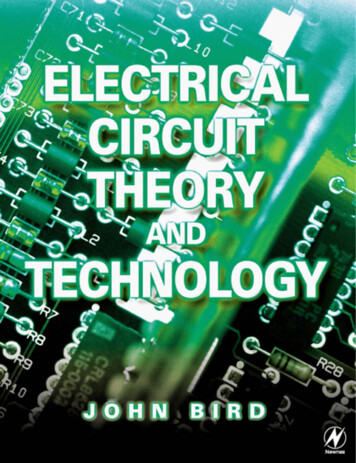
Transcription
Electrical Circuit Theory and TechnologyJohn Bird
In Memory of Elizabeth
Electrical Circuit Theory and TechnologyRevised second editionJohn Bird, BSc(Hons), CEng, MIEE, FIEIE, CMath,FIMA, FCollPNewnesOXFORD AMSTERDAM BOSTON LONDON NEW YORK PARISSAN DIEGO SAN FRANCISCO SINGAPORE SYDNEY TOKYO
NewnesAn imprint of Elsevier ScienceLinacre House, Jordan Hill, Oxford OX2 8DP200 Wheeler Rd, Burlington, MA 01803First published 1997Second edition 2001Reprinted 2002Revised second edition 2003Copyright 1997, 2001, John Bird. All rights reservedThe right of John Bird to be identified as the author of this workhas been asserted in accordance with the Copyright, Designsand Patents Act 1988No part of this publication may be reproduced in any materialform (including photocopying or storing in any medium byelectronic means and whether or not transiently or incidentally to someother use of this publication) without the written permission of thecopyright holder except in accordance with the provisions of the Copyright,Designs and Patents Act 1988 or under the terms of a licence issued by theCopyright Licensing Agency Ltd, 90 Tottenham Court Road, London,England W1P 4LP. Applications for the copyright holder’s writtenpermission to reproduce any part of this publication should be addressedto the publisherBritish Library Cataloguing in Publication DataA catalogue record for this book is available from the British LibraryISBN 0 7506 5784 7For information on all Newnes publications visit our website atwww.newnespress.comTypeset by Laser Words, Madras, IndiaPrinted and bound in Great Britain
ContentsPrefacexviiPart 1 Basic electrical engineering principles1 Units associated withbasic electricalquantities2 An introduction toelectric 42.52.62.72.82.92.102.112.12SI unitsChargeForceWorkPowerElectrical potential and e.m.f.Resistance and conductanceElectrical power and energySummary of terms, units and their symbolsFurther problems on units associatedwith basic electrical quantities344556678Standard symbols for electrical componentsElectric current and quantity of electricityPotential difference and resistanceBasic electrical measuring instrumentsLinear and non-linear devicesOhm’s lawMultiples and sub-multiplesConductors and insulatorsElectrical power and energyMain effects of electric currentFusesFurther problems on the introduction toelectric circuits10111313131414161620209213 Resistance variation3.13.23.3Resistance and resistivityTemperature coefficient of resistanceFurther problems on resistance variation2326294 Chemical effects trolysisElectroplatingThe simple cellCorrosionE.m.f. and internal resistance of a cellPrimary cells31313232333436
vi Contents4.84.94.10Secondary cellsCell capacityFurther problems on the chemical effects of electricity373939Assignment 1415 Series and parallelnetworks5.15.25.35.45.55.6Series circuitsPotential dividerParallel networksCurrent divisionWiring lamps in series and in parallelFurther problems on series and parallel networks4244454852536 Capacitors .126.13Electrostatic fieldElectric field strengthCapacitanceCapacitorsElectric flux densityPermittivityThe parallel plate capacitorCapacitors connected in parallel and seriesDielectric strengthEnergy storedPractical types of capacitorDischarging capacitorsFurther problems on capacitors and capacitance555757575959616367686970707 Magnetic circuits7.17.27.37.47.57.67.77.87.9Magnetic fieldsMagnetic flux and flux densityMagnetomotive force and magnetic field strengthPermeability and B–H curvesReluctanceComposite series magnetic circuitsComparison between electrical and magnetic quantitiesHysteresis and hysteresis lossFurther problems on magnetic circuits7475767780818484858 ElectromagnetismAssignment 2878.18.28.38.48.58.68.789919296979898Magnetic field due to an electric currentElectromagnetsForce on a current-carrying conductorPrinciple of operation of a simple d.c. motorPrinciple of operation of a moving coil instrumentForce on a chargeFurther problems on electromagnetism
Contents vii9 Electromagneticinduction10 Electrical measuringinstruments n to electromagnetic inductionLaws of electromagnetic inductionInductanceInductorsEnergy storedInductance of a coilMutual inductanceFurther problems on electromagnetic 0.5IntroductionAnalogue instrumentsMoving-iron instrumentThe moving-coil rectifier instrumentComparison of moving-coil, moving-iron andmoving-coil rectifier instrumentsShunts and multipliersElectronic instrumentsThe ohmmeterMultimetersWattmetersInstrument ‘loading’ effectThe cathode ray oscilloscopeWaveform harmonicsLogarithmic ratiosNull method of measurementWheatstone bridgeD.c. potentiometerA.c. bridgesMeasurement errorsFurther problems on electrical measuringinstruments and 511711711811811812112412612912913013013113311 8Types of materialsSilicon and germaniumn-type and p-type materialsThe p-n junctionForward and reverse biasSemiconductor diodesRectificationFurther problems on semiconductor diodes13713813813914014014314312 Transistors12.112.212.312.412.512.612.712.8The bipolar junction transistorTransistor actionTransistor symbolsTransistor connectionsTransistor characteristicsThe transistor as an amplifierThe load lineCurrent and voltage gains145147149149150152154155
viii Contents12.912.10Thermal runawayFurther problems on transistors158159Assignment 3162Main formulae for Part 1164Part 2 Electrical principles and technology13 D.c. circuit roductionKirchhoff’s lawsThe superposition theoremGeneral d.c. circuit theoryThévenin’s theoremConstant-current sourceNorton’s theoremThévenin and Norton equivalent networksMaximum power transfer theoremFurther problems on d.c. circuit theory16716717117417618118118418718914 Alternating voltagesand onThe a.c. generatorWaveformsA.c. valuesThe equation of a sinusoidal waveformCombination of waveformsRectificationFurther problems on alternating voltages and currents193193194195200204208209Assignment 421215 Single-phase seriesa.c. 5.1115.12Purely resistive a.c. circuitPurely inductive a.c. circuitPurely capacitive a.c. circuitR–L series a.c. circuitR–C series a.c. circuitR–L –C series a.c. circuitSeries resonanceQ-factorBandwidth and selectivityPower in a.c. circuitsPower triangle and power factorFurther problems on single-phase series a.c. circuits21321421421522022122522722923023223416 Single-phase parallela.c. circuits16.116.216.3IntroductionR–L parallel a.c. circuitR–C parallel a.c. circuit238238240
Contents ix16.416.516.616.716.8L –C parallel a.c. circuitLR–C parallel a.c. circuitParallel resonance and Q-factorPower factor improvementFurther problems on single-phase parallel a.c. circuits24124324725225617 D.c. 017.1117.12IntroductionCharging a capacitorTime constant for a C–R circuitTransient curves for a C–R circuitDischarging a capacitorCurrent growth in an L –R circuitTime constant for an L –R circuitTransient curves for an L –R circuitCurrent decay in an L –R circuitSwitching inductive circuitsThe effects of time constant on a rectangular waveformFurther problems on d.c. transients25926026026126626826926927227527527618 18.818.918.1018.1118.12Introduction to operational amplifiersSome op amp parametersOp amp inverting amplifierOp amp non-inverting amplifierOp amp voltage-followerOp amp summing amplifierOp amp voltage comparatorOp amp integratorOp amp differential amplifierDigital to analogue (D/A) conversionAnalogue to digital (A/D) conversionFurther problems on operational ignment 529619 Three phase ctionThree-phase supplyStar connectionDelta connectionPower in three-phase systemsMeasurement of power in three-phase systemsComparison of star and delta connectionsAdvantages of three-phase systemsFurther problems on three-phase systems29729729830230330631231231220 r principle of operationTransformer no-load phasor diagramE.m.f. equation of a transformer315316319320
x .1420.1520.1621 D.c. machines22 Three-phaseinduction motorsTransformer on-load phasor diagramTransformer constructionEquivalent circuit of a transformerRegulation of a transformerTransformer losses and efficiencyResistance matchingAuto transformersIsolating transformersThree-phase transformersCurrent transformersVoltage transformersFurther problems on signment troductionThe action of a commutatorD.c. machine constructionShunt, series and compound windingsE.m.f. generated in an armature windingD.c. generatorsTypes of d.c. generator and theircharacteristicsD.c. machine lossesEfficiency of a d.c. generatorD.c. motorsTorque of a d.c. machineTypes of d.c. motor and their characteristicsThe efficiency of a d.c. motorD.c. motor starterSpeed control of d.c. motorsMotor coolingFurther problems on d.c. 2.1122.1222.1322.1422.15IntroductionProduction of a rotating magnetic fieldSynchronous speedConstruction of a three-phase induction motorPrinciple of operation of a three-phase induction motorSlipRotor e.m.f. and frequencyRotor impedance and currentRotor copper lossInduction motor losses and efficiencyTorque equation for an induction motorInduction motor torque–speed characteristicsStarting methods for induction motorsAdvantages of squirrel-cage induction motorsAdvantages of wound rotor induction 356362363364365368373376377381381
Contents xi22.16 Double cage induction motor22.17 Uses of three-phase induction motors22.18 Further problems on three-phase induction motors405405406Assignment 7408Main formulae for Part 2409Part 3 Advanced circuit theory and technology23 Revision of IntroductionOperations involving Cartesian complex numbersComplex equationsThe polar form of a complex numberMultiplication and division using complex numbersin polar formDe Moivre’s theorem — powers and roots ofcomplex numbersFurther problems on complex numbers24 Application ofcomplex numbers toseries a.c. circuits24.124.224.3IntroductionSeries a.c. circuitsFurther problems on series a.c. circuits42942944025 Application ofcomplex numbers toparallel a.c. networks25.125.225.325.4IntroductionAdmittance, conductance and susceptanceParallel a.c. networksFurther problems on parallel a.c. networks44444444845426 Power in a.c. ination of power in a.c. circuitsPower triangle and power factorUse of complex numbers for determination of powerPower factor improvementFurther problems on power in a.c. circuits45945946446547047223.6421423424Assignment 847527 A.c. bridges27.127.227.327.4IntroductionBalance conditions for an a.c. bridgeTypes of a.c. bridge circuitFurther problems on a.c. bridges47647647848828 Series resonance andQ-factor28.128.228.3IntroductionSeries resonanceQ-factor491491495
xii Contents29 Parallel resonanceand Q-factor30 Introduction tonetwork analysis28.428.528.628.728.8Voltage magnificationQ-factors in seriesBandwidthSmall deviations from the resonant frequencyFurther problems on series resonance and roductionThe LR–C parallel networkDynamic resistanceThe LR–CR parallel networkQ-factor in a parallel networkFurther problems on parallel resonance andQ-factor515516517517519Assignment 953030.130.2IntroductionSolution of simultaneous equations usingdeterminantsNetwork analysis using Kirchhoff’s lawsFurther problems on Kirchhoff’s laws531Mesh-current analysisNodal analysisFurther problems on mesh-current and nodalanalysis54555030.330.431 Mesh-current andnodal analysis52731.131.231.353253554255932 The superpositiontheorem32.132.232.3IntroductionUsing the superposition theoremFurther problems on the superposition theorem56256257333 Thévenin’s andNorton’s ’s theoremNorton’s theoremThévenin and Norton equivalent networksFurther problems on Thévenin’s and Norton’stheorem57557558759334 Delta-star andstar-deltatransformations598Assignment elta and star connectionsDelta-star transformationStar-delta transformationFurther problems on delta-star andstar-delta transformations614
Contents xiii35 Maximum powertransfer theoremsand impedancematching36 Complex ctionThe general equation for a complex waveformHarmonic synthesisRms value, mean value and the form factorof a complex wavePower associated with complex wavesHarmonics in single-phase circuitsResonance due to harmonicsSources of harmonicsFurther problems on complex waveforms631632633IntroductionHarmonic analysis on data given intabular or graphical formComplex waveform considerationsFurther problems on a numerical method ofharmonic analysis678Revision of terms and units used with magnetic circuitsMagnetic properties of materialsHysteresis and hysteresis lossEddy current lossSeparation of hysteresis and eddy current lossesNonpermanent magnetic materialsPermanent magnetic materialsFurther problems on magnetic 8 Magnetic materials617623Assignment 1136.536.636.736.836.937 A numerical methodof harmonic analysisMaximum power transfer theoremsImpedance matchingFurther problems on maximum power transfertheorems and impedance 64666671678683685Assignment 1271039 Dielectrics anddielectric loss39.139.239.339.439.539.639.739.839.9Electric fields, capacitance and permittivityPolarizationDielectric strengthThermal effectsMechanical propertiesTypes of practical capacitorLiquid dielectrics and gas insulationDielectric loss and loss angleFurther problems on dielectric loss and loss angle71171171271471471571571571940 Field theory40.140.2Field plotting by curvilinear squaresCapacitance between concentric cylinders720725
xiv Contents41 Attenuators40.340.440.540.640.740.840.9Capacitance of an isolated twin lineEnergy stored in an electric fieldInduced e.m.f. and inductanceInductance of a concentric cylinder (or coaxial cable)Inductance of an isolated twin lineEnergy stored in an electromagnetic fieldFurther problems on field 641.741.841.9IntroductionCharacteristic impedanceLogarithmic ratiosSymmetrical T-and -attenuatorsInsertion lossAsymmetrical T- and -sectionsThe L-section attenuatorTwo-port networks in cascadeFurther problems on attenuators758759761764772775779782785Assignment 1378942.142.242.3IntroductionBasic types of filter sectionsThe characteristic impedance and the attenuation offilter sections42.4Ladder networks42.5Low-pass filter sections42.6High-pass filter sections42.7Propagation coefficient and time delay infilter sections42.8‘m-derived’ filter sections42.9Practical composite filters42.10 Further problems on filter networks79079143 Magnetically roductionSelf-inductanceMutual inductanceCoupling coefficientCoils connected in seriesCoupled circuitsDot rule for coupled circuitsFurther problems on magnetically coupled circuits84184184284384584985786444 Transmission lines44.144.244.344.444.5IntroductionTransmission line primary constantsPhase delay, wavelength and velocity of propagationCurrent and voltage relationshipsCharacteristic impedance and propagationcoefficient in terms of the primary constants86986987187342 Filter networks792795797807815825833837875
Contents xv44.644.744.844.945 Transients andLaplace transformsDistortion on transmission linesWave reflection and the reflection coefficientStanding waves and the standing wave ratioFurther problems on transmission ionResponse of R–C series circuit to a step inputResponse of R–L series circuit to a step inputL –R–L series circuit responseIntroduction to Laplace transformsInverse Laplace transforms and the solution ofdifferential equations45.7Laplace transform analysis directly from the circuitdiagram45.8L –R–C series circuit using Laplace transforms45.9Initial conditions45.10 Further problems on transients and Laplace transforms901901906910914Assignment 14958Main formulae for Part 3960921930944949952Part 4 General referenceStandard electrical quantities — their symbols and units968Greek alphabet971Common prefixes972Resistor colour coding and ohmic values973Index975
This Page Intentionally Left Blank
Preface‘Electrical Circuit Theory and Technology, Revised second Edition’provides coverage for a wide range of courses that contain electricalprinciples, circuit theory and technology in their syllabuses, fromintroductory to degree level. The chapter ‘Transients and Laplacetransforms’, which had been removed from the second edition due to pagerestraints, has been included in this edition in response to popular demand.The text is set out in four parts as follows:PART 1, involving chapters 1 to 12, contains ‘Basic ElectricalEngineering Principles’ which any student wishing to progress inelectrical engineering would need to know. An introduction to electricalcircuits, resistance variation, chemical effects of electricity, seriesand parallel circuits, capacitors and capacitance, magnetic circuits,electromagnetism, electromagnetic induction, electrical measuringinstruments and measurements, semiconductor diodes and transistors areall included in this section.PART 2, involving chapters 13 to 22, contains ‘Electrical Principlesand Technology’ suitable for Advanced GNVQ, National Certificate,National Diploma and City and Guilds courses in electrical and electronicengineering. D.c. circuit theory, alternating voltages and currents,single-phase series and parallel circuits, d.c. transients, operationalamplifiers, three-phase systems, transformers, d.c. machines and threephase induction motors are all included in this section.PART 3, involving chapters 23 to 45, contains ‘Advanced CircuitTheory and Technology’ suitable for Degree, Higher NationalCertificate/Diploma and City and Guilds courses in electrical andelectronic/telecommunications engineering. The two earlier sections of thebook will provide a valuable reference/revision for students at this level.Complex numbers and their application to series and parallel networks,power in a.c. circuits, a.c. bridges, series and parallel resonance andQ-factor, network analysis involving Kirchhoff’s laws, mesh and nodalanalysis, the superposition theorem, Thévenin’s and Norton’s theorems,delta-star and star-delta transforms, maximum power transfer theoremsand impedance matching, complex waveforms, harmonic analysis,magnetic materials, dielectrics and dielectric loss, field theory, attenuators,filter networks, magnetically coupled circuits, transmission line theory andtransients and Laplace transforms are all included in this section.PART 4 provides a short, ‘General Reference’ for standard electricalquantities — their symbols and units, the Greek alphabet, commonprefixes and resistor colour coding and ohmic values.At the beginning of each of the 45 chapters learning objectivesare listed.At the end of each of the first three parts of the text is a handy referenceof the main formulae used.
xviii Electrical Circuit Theory and TechnologyIt is not possible to acquire a thorough understanding of electricalprinciples, circuit theory and technology without working through a largenumber of numerical problems. It is for this reason that ‘Electrical CircuitTheory and Technology, Revised second Edition’ contains some 740detailed worked problems, together with over 1100 further problems,all with answers in brackets immediately following each question. Over1100 line diagrams further enhance the understanding of the theory.Fourteen Assignments have been included, interspersed within thetext every few chapters. For example, Assignment 1 tests understandingof chapters 1 to 4, Assignment 2 tests understanding of chapters 5 to 7,Assignment 3 tests understanding of chapters 8 to 12, and so on. TheseAssignments do not have answers given since it is envisaged that lecturerscould set the Assignments for students to attempt as part of their coursestructure. Lecturers’ may obtain a complimentary set of solutions of theAssignments in an Instructor’s Manual available from the publishersvia the internet — see below.‘Learning by Example’ is at the heart of ‘Electrical Circuit Theoryand Technology, Revised second Edition’.JOHN BIRDUniversity of Portsmouth
Free web downloadsInstructor’s ManualFull worked solutions and mark scheme for all the Assignments inthis book.This material is available to lecturers only. To obtain a passwordplease e-mail j.Blackfond@Elsevier.com with the followingdetails: course title, number of students, your job title and workpostal address.To download the Instructor’s Manual visithttp://www.newnespress.comand enter the book title in the search box, or use the followingdirect URL:http://www.bh.com/manuals/0750657847/For up-to-date information on all Newnes textbooks visit ingRegister as a user to receive regular e-mail bulletins.If you have any suggestions for how we could improve this bookin future editions, corrections, or ideas for our future publishingprogramme please e-mail Newnes at:newnes@Elsevier.com
This Page Intentionally Left Blank
Part 1 Basic ElectricalEngineeringPrinciples
This Page Intentionally Left Blank
1Units associated withbasic electrical quantitiesAt the end of this chapter you should be able to:žžžžstate the basic SI unitsrecognize derived SI unitsunderstand prefixes denoting multiplication and divisionstate the units of charge, force, work and power and performsimple calculations involving these unitsž state the units of electrical potential, e.m.f., resistance,conductance, power and energy and perform simplecalculations involving these units1.1 SI unitsThe system of units used in engineering and science is the Système Internationale d’Unités (International system of units), usually abbreviated toSI units, and is based on the metric system. This was introduced in 1960and is now adopted by the majority of countries as the official system ofmeasurement.The basic units in the SI system are listed with their symbols, inTable 1.1.TABLE 1.1Basic SI UnitsQuantityUnitlengthmasstimeelectric currentthermodynamic temperatureluminous intensityamount of substancemetre, mkilogram, kgsecond, sampere, Akelvin, Kcandela, cdmole, molDerived SI units use combinations of basic units and there are many ofthem. Two examples are:žžVelocity — metres per second (m/s)Acceleration — metres per second squared (m/s2 )
4 Electrical Circuit Theory and TechnologySI units may be made larger or smaller by using prefixes which denotemultiplication or division by a particular amount. The six most commonmultiples, with their meaning, are listed in Table 1.2.TABLE 1.21.2 ChargePrefixNameMeaningMkm npmegakilomillimicronanopicomultiply by 1 000 000multiply by 1000divide by 1000divide by 1 000 000divide by 1 000 000 000divide by 1 000 000 000 000(i.e.(i.e.(i.e.(i.e.(i.e.(i.e.ð106 )ð103 )ð10 3 )ð10 6 )ð10 9 )ð10 12 )The unit of charge is the coulomb (C) where one coulomb is one amperesecond. (1 coulomb D 6.24 ð 1018 electrons). The coulomb is defined asthe quantity of electricity which flows past a given point in an electriccircuit when a current of one ampere is maintained for one second. Thus,charge, in coulombs Q Itwhere I is the current in amperes and t is the time in seconds.Problem 1. If a current of 5 A flows for 2 minutes, find the quantity of electricity transferred.Quantity of electricity Q D It coulombsI D 5 A, t D 2 ð 60 D 120 sHence Q D 5 ð 120 D 600 C1.3ForceThe unit of force is the newton (N) where one newton is one kilogrammetre per second squared. The newton is defined as the force which, whenapplied to a mass of one kilogram, gives it an acceleration of one metreper second squared. Thus,force, in newtons F mawhere m is the mass in kilograms and a is the acceleration in metresper second squared. Gravitational force, or weight, is mg, where g D9.81 m/s2
Units associated with basic electrical quantities 5Problem 2. A mass of 5000 g is accelerated at 2 m/s2 by a force.Determine the force needed.Force D mass ð accelerationD 5 kg ð 2 m/s2 D 10kg mD 10 Ns2Problem 3. Find the force acting vertically downwards on a massof 200 g attached to a wire.Mass D 200 g D 0.2 kg and acceleration due to gravity, g D 9.81 m/s2Force acting downwards D weight D mass ð accelerationD 0.2 kg ð 9.81 m/s2D 1.962 N1.4 WorkThe unit of work or energy is the joule (J) where one joule is one newtonmetre. The joule is defined as the work done or energy transferred whena force of one newton is exerted through a distance of one metre in thedirection of the force. Thuswork done on a body, in joules W Fswhere F is the force in newtons and s is the distance in metres movedby the body in the direction of the force. Energy is the capacity fordoing work.1.5 PowerThe unit of power is the watt (W) where one watt is one joule per second.Power is defined as the rate of doing work or transferring energy. Thus,power in watts, P Wtwhere W is the work done or energy transferred in joules and t is thetime in seconds. Thusenergy, in joules, W Pt
6 Electrical Circuit Theory and TechnologyProblem 4. A portable machine requires a force of 200 N to moveit. How much work is done if the machine is moved 20 m and whataverage power is utilized if the movement takes 25 s?Work done D force ð distance D 200 N ð 20 m D 4000 Nm or 4 kJPower Dwork done4000 JDD 160 J s 160 Wtime taken25 sProblem 5. A mass of 1000 kg is raised through a height of 10 min 20 s. What is (a) the work done and (b) the power developed?(a)Work done D force ð distance and force D mass ð accelerationHence, work done D 1000 kg ð 9.81 m/s2 ð 10 m D 98 100 Nm D 98.1 kNm or 98.1 kJ(b)1.6 Electrical potentialand e.m.f.Power D98100 Jwork doneDD 4905 J/stime taken20 sD 4905 W or 4.905 kWThe unit of electric potential is the volt (V) where one volt is one jouleper coulomb. One volt is defined as the difference in potential betweentwo points in a conductor which, when carrying a current of one ampere,dissipates a power of one watt, i.e.volts pere secondscoulombsA change in electric potential between two points in an electric circuit iscalled a potential difference. The electromotive force (e.m.f.) providedby a source of energy such as a battery or a generator is measured in volts.1.7 Resistance andconductanceThe unit of electric resistance is the ohm (Z) where one ohm is onevolt per ampere. It is defined as the resistance between two points in aconductor when a constant electric potential of one volt applied at thetwo points produces a current flow of one ampere in the conductor. Thus,resistance, in ohms R VI
Units associated with basic electrical quantities 7where V is the potential difference across the two points in volts and I isthe current flowing between the two points in amperes.The reciprocal of resistance is called conductance and is measured insiemens (S). Thus,conductance, in siemensG 1Rwhere R is the resistance in ohms.Problem 6. Find the conductance of a conductor of resistance(a) 10 , (b) 5 k and (c) 100 m 1.8 Electrical power andenergy11Dsiemen D 0.1 sR10(a)Conductance G D(b)GD11DS D 0.2 ð 10 3 S D 0.2 mSR5 ð 103(c)GD10311SDDS D 10 S 3R100 ð 10100When a direct current of I amperes is flowing in an electric circuit andthe voltage across the circuit is V volts, thenpower, in watts P VIElectrical energy D Power ð timeD VIt JoulesAlthough the unit of energy is the joule, when dealing with large amountsof energy, the unit used is the kilowatt hour (kWh) where1 kWh D 1000 watt hourD 1000 ð 3600 watt seconds or joulesD 3 600 000 JProblem 7. A source e.m.f. of 5 V supplies a current of 3 A for10 minutes. How much energy is provided in this time?Energy D power ð time and power D voltage ð current. Hence
8 Electrical Circuit Theory and TechnologyEnergy D VIt D 5 ð 3 ð 10 ð 60 D 9000 Ws or JD 9 kJProblem 8. An electric heater consumes 1.8 MJ when connectedto a 250 V supply for 30 minutes. Find the power rating of theheater and the current taken from the supply.i.e. Power rating of heater 1 kWPower P D VI, thus I D1000PDD4AV250Hence the current taken from the supply is 4 A1.9 Summary of terms,units and their yAccelerationlmtvaForceElectrical chargeor quantityElectric ntialdifferenceWorkEnergyPowerFQIRGUnitUnit symbolmetrekilogramsecondmetres per secondmetres persecond squarednewtoncoulombmkgsm/s or m s 1m/s2 or m s 2NCampereohmsiemenvoltA SVvoltVjoulejoulewattJJWEVWE (or W)PAs progress is made through Electrical Circuit Theory and Technologymany more terms will be met. A full list of electrical quantities, togetherwith their symbols and units are given in Part 4, page 968.
Units associated with basic electrical quantities 91.10 Further problemson units associated withbasic electrical
20.5 Transformer on-load phasor diagram 20.6 Transformer construction 20.7 Equivalent circuit of a transformer 20.8 Regulation of a transformer 20.9 Transformer losses and efficiency 20.10 Resistance matching 20.11 Auto transformers 20.12 Isolating transformers 20.13 Three-phase transformers 20.14
